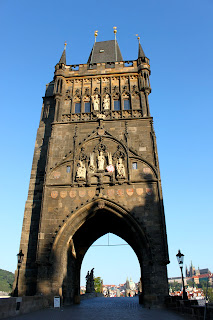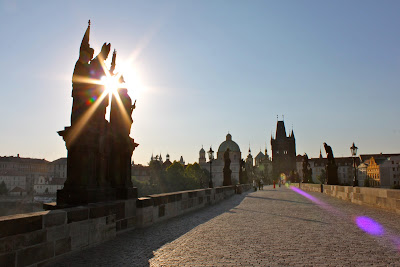Today was our last day in Krakow. It's a truly lovely city, and we've really enjoyed being here in the glorious sunny weather. It's been very easy to walk everywhere, not only due to the flat cobblestone streets, but also because it is home to a veritable smorgasbord of interesting sights, sounds, and smells, which distract you until you arrive at your destination.
 |
| The Cahedral at Wawel Hill, showing a mix of architectural styles. |

We started the day at Wawel Hill, which is one of the most iconic sights in Poland. This is where the Royal Family lived and held court, and it is also where the Nazis set up their base in Krakow. The grounds and gold-covered, ornate cathedral are free and lovely to wander, though very crowded. We paid extra for entry to the elaborate State Rooms, home to the Royal family's impressive collection of tapestries and pieces of art. To our delight, a very famous painting, Da Vinci's
Lady With An Ermine, was on loan to the castle, and we were able to learn about the painting's history, as well as the woman depicted in it. At the end of the exhibit, Kelly and I were able to closely admire the amazing work, appreciating

the invisible brush strokes, incredible detail, and realism that Da Vinci was able to create. After exploring the castle and grounds, we decided to leave in an unusual fashion: through the infamous Dragon's Den. Rumor has it that in days of yore, a prince fed a sheep explosive material and left it just outside Wawel Hill, where a dragon, who had been plaguing the city and eating its princesses, lived. The dragon ate the sheep, and in the fires of the dragon's belly, the sheep exploded, killing the dragon, ridding Krakow of its scourge, and freeing the beautiful princess, who married the Prince and lived happily ever after. These days, the Den is a huge cave that leads from the castle to the river bank. There we rested, hiding from the promise of sunburn in the shade, eating more of the delicious, cheap bread that is sold everywhere.
 |
| The fearsome dragon! |
Feeling re-energized, we began the long trek to Oskar Schindler's enamel factory, which has been converted into a museum about life in Poland during the Nazi occupation. It was a wonderful surprise, well organized, very detailed and informative, and interactive. We spent several hours there learning more about the hardship of the Polish people beyond its Jewish inhabitants, although life in the Ghetto and the story of Schindler's list were also delved into.

Now exhausted after hours of walking and standing, we headed back towards Rynek Glowny, the main square, and entered St. Mary's Cathedral, which dominates the North Eastern corner of the Square. It is an awe-inspiring example of Gothic architecture, and everything inside is covered in gold. Contrary to Wawel Cathedral, which sees less traffic from average Poles, St. Mary's was full of people dropping reverently to their knees on the cold marble. Returning to the bright square, Kel and I meandered through the numerous artisan's stands, before finding a restaurant in which to enjoy a last meal of delectable pierogis.
 |
| Rynek Glowny, with St. Mary's Cathedral in the background. |
It has been wonderful visiting this city. From my understanding, it is less touristy and busy than other capitols of culture in Eastern Europe. We haven't had to cue for anything, and the cost of living and sightseeing here is very low. The people have been helpful and friendly, and the language, though very difficult to speak, is beautiful to listen to. Tomorrow we'll be leaving first thing in the morning on our long trek to Prague, and though I'm very excited to visit the reputably beautiful city, I'm sad to be leaving Krakow behind just as we're beginning to feel comfortable finding our way around the winding streets and intricate language. But so it goes, see you all in Prague!

 On our second full day in Prague, we got up at the crack of dawn to visit Karlov Most (the Charles Bridge) without being in a crowd of tourists. The light was lovely in the morning, and we really enjoyed the opportunity to photograph the city before it woke up. We went back to the Old Town Square again as well, for an unobstructed view of the Astronomical Clock which is one of the main attractions. It is the oldest astronomical clock that still works, as it was installed in 1410. Every hour it delights visitors with apostles and skulls ringing the bells, and time-telling aside, it is a piece of art. We were quite tired after our short sleep, so we both went back to the hostel to crash for a bit. Then in the afternoon, we went to meet up with some local Prague folk who I met on the website couch surfing. The first fellow was named David, and he took us up a back route of Prague Castle. We walked up to the hill where there once stood the largest statue of Josef Stalin, set up a slack line, and chatted and fell for a time. We wrapped up our visit with a beer in a garden overlooking the city, which was really lovely. Later that evening we had a rendezvous with a lady named Daniela, who wanted to chat with us about Canada, as she and her husband are making a trip there this summer. She works part-time with a boating company which runs tours along the Vltava river under the Charles Bridge, and she invited us to take a trip with them the next day. Our last day in Prague started with the aforementioned boat tour, which was informative and fun. We carried on from there to Petrin tower, a mini replica of the Eiffel Tower which sits on a hill overlooking the city. It was splendid to get an aerial view of the Castle complex, as well as the rest of the town. Feeling very tired, we opted to hang out in the green space on Petrin hill to nap and read.
On our second full day in Prague, we got up at the crack of dawn to visit Karlov Most (the Charles Bridge) without being in a crowd of tourists. The light was lovely in the morning, and we really enjoyed the opportunity to photograph the city before it woke up. We went back to the Old Town Square again as well, for an unobstructed view of the Astronomical Clock which is one of the main attractions. It is the oldest astronomical clock that still works, as it was installed in 1410. Every hour it delights visitors with apostles and skulls ringing the bells, and time-telling aside, it is a piece of art. We were quite tired after our short sleep, so we both went back to the hostel to crash for a bit. Then in the afternoon, we went to meet up with some local Prague folk who I met on the website couch surfing. The first fellow was named David, and he took us up a back route of Prague Castle. We walked up to the hill where there once stood the largest statue of Josef Stalin, set up a slack line, and chatted and fell for a time. We wrapped up our visit with a beer in a garden overlooking the city, which was really lovely. Later that evening we had a rendezvous with a lady named Daniela, who wanted to chat with us about Canada, as she and her husband are making a trip there this summer. She works part-time with a boating company which runs tours along the Vltava river under the Charles Bridge, and she invited us to take a trip with them the next day. Our last day in Prague started with the aforementioned boat tour, which was informative and fun. We carried on from there to Petrin tower, a mini replica of the Eiffel Tower which sits on a hill overlooking the city. It was splendid to get an aerial view of the Castle complex, as well as the rest of the town. Feeling very tired, we opted to hang out in the green space on Petrin hill to nap and read.








 glass threw purple and blue light over the gothic interior, and we enjoyed playing with various shutter speeds and white balances on our cameras. We then hiked 343 stairs up one of the towers to get a view of the city from above. Moving on from the main square, we walked to the Hofburg complex, where the Hapsburg Rose Gardens blew us away. The roses are so fragrant that you can smell them from several blocks away, and they come in every size, shape and colour. It was a rejuvenating place to be in the middle of the day, sitting amongst roses in the sunshine. We then toured the Kaiser apartments and the Sisi Museum, both of which provided a portrait into the life of the Royal Hapsburg family in the 19th century. It was interesting to learn about Emperess Elisabeth's tragic life, and the bizarre cult of personality that surrounds her, even in death. For dinner this evening, Gary took us to a local restaurant with his friends Pepi and Lizzie, who I have met before, and we devoured the most delicious asparagus I've ever tasted.
glass threw purple and blue light over the gothic interior, and we enjoyed playing with various shutter speeds and white balances on our cameras. We then hiked 343 stairs up one of the towers to get a view of the city from above. Moving on from the main square, we walked to the Hofburg complex, where the Hapsburg Rose Gardens blew us away. The roses are so fragrant that you can smell them from several blocks away, and they come in every size, shape and colour. It was a rejuvenating place to be in the middle of the day, sitting amongst roses in the sunshine. We then toured the Kaiser apartments and the Sisi Museum, both of which provided a portrait into the life of the Royal Hapsburg family in the 19th century. It was interesting to learn about Emperess Elisabeth's tragic life, and the bizarre cult of personality that surrounds her, even in death. For dinner this evening, Gary took us to a local restaurant with his friends Pepi and Lizzie, who I have met before, and we devoured the most delicious asparagus I've ever tasted.




































